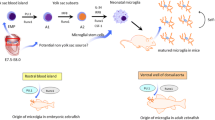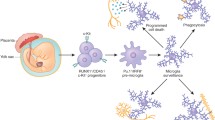Abstract
Microglia are the tissue macrophage of the central nervous system (CNS) and their activation is among the earliest signs of CNS dysfunction and disease. Because microglia express many macrophage markers, they are presumed to act primarily as effectors of CNS inflammation and destruction. While such responses are beneficial to the extent that they destroy CNS pathogens, these responses do have the potential to have neurotoxic outcomes. Consequently, therapies for many CNS neurodegenerative and inflammatory diseases have been directed at suppressing microglial function.
There is evidence to suggest that microglia play an important role during CNS development and maintenance of CNS function that may go beyond simple defense against pathogens. Molecular analysis of microglial phenotypes and function has revealed three striking findings: (i) that microglia are a unique CNS-specific type of tissue macrophage; (ii) that they are highly heterogeneous within the healthy CNS; and (iii) that microglial responses are exquisitely tailored to specific regions of the CNS and specific pathological insults. We suggest that ubiquitous suppression (rather than targeted manipulation) of microglial function may fail to fully ameliorate CNS pathology and may even ultimately promote maladaptive outcomes.



Similar content being viewed by others
References
Lo D, Feng LL, Li L, et al. Integrating innate and adaptive immunity in the whole animal. Immunol Rev 1999; 169: 225–39
Carson MJ. Microglia as liaisons between the immune and central nervous systems: functional implications for multiple sclerosis. Glia 2002; 40(2): 218–31
Streit WJ. Microglial response to brain injury: a brief synopsis. Toxicol Pathol 2000; 28(1): 28–30
Aloisi F. Immune function of microglia. Glia 2001; 36(2): 165–79
Matyszak MK. Inflammation in the CNS: balance between immunological privilege and immune responses. Prog Neurobiol 1998; 56(1): 19–35
Kreutzberg GW. Microglia: a sensor for pathological events in the CNS. Trends Neurosci 1996; 19(8): 312–8
Balcaitis S, Xie Y, Weinstein JR, et al. Expression of proteinase-activated receptors in mouse microglial cells. Neuroreport 2003; 14(18): 2373–7
Moller T, Hanisch UK, Ransom BR. Thrombin-induced activation of cultured rodent microglia. J Neurochem 2000; 75(4): 1539–47
Boucsein C, Zacharias R, Farber K, et al. Purinergic receptors on microglial cells: functional expression in acute brain slices and modulation of microglial activation in vitro. Eur J Neurosci 2003; 17(11): 2267–76
Hickey WF, Kimura H. Perivascular microglial cells of the CNS are bone marrow-derived and present antigen in vivo. Science 1988; 239(4837): 290–2
Matsumoto Y, Fujiwara M. Absence of donor-type major histocompatibility complex class I antigen-bearing microglia in the rat central nervous system of radiation bone marrow chimeras. J Neuroimmunol 1987; 17(1): 71–82
Vallieres L, Sawchenko PE. Bone marrow-derived cells that populate the adult mouse brain preserve their hematopoietic identity. J Neurosci 2003; 23(12): 5197–207
Sedgwick JD, Schwender S, Imrich H, et al. Isolation and direct characterization of resident microglial cells from the normal and inflamed central nervous system. Proc Natl Acad Sci U S A 1991; 88(16): 7438–42
Renno T, Krakowski M, Piccirillo C, et al. TNF-alpha expression by resident microglia and infiltrating leukocytes in the central nervous system of mice with experimental allergic encephalomyelitis: regulation by Th1 cytokines. J Immunol 1995; 154(2): 944–53
Carson MJ, Reilly CR, Sutcliffe JG, et al. Mature microglia resemble immature antigen-presenting cells. Glia 1998; 22(1): 72–85
Irie-Sasaki J, Sasaki T, Penninger JM. CD45 regulated signaling pathways. Curr Top Med Chem 2003; 3(7): 783–96
Hermiston ML, Xu Z, Weiss A. CD45: a critical regulator of signaling thresholds in immune cells. Annu Rev Immunol 2003; 21: 107–37
Penninger JM, Irie-Sasaki J, Sasaki T, et al. CD45: new jobs for an old acquaintance. Nat Immunol 2001; 2(5): 389–96
Tan J, Town T, Mori T, et al. CD45 opposes beta-amyloid peptide-induced microglial activation via inhibition of p44/42 mitogen-activated protein kinase. J Neurosci 2000; 20(20): 7587–94
Tan J, Town T, Mullan M. CD45 inhibits CD40L-induced microglial activation via negative regulation of the Src/p44/42 MAPK pathway. J Biol Chem 2000; 275(47): 37224–31
Hailer NP, Heppner FL, Haas D, et al. Fluorescent dye prelabelled microglial cells migrate into organotypic hippocampal slice cultures and ramify. Eur J Neurosci 1997; 9(4): 863–6
Carson MJ, Reilly CR, Sutcliffe JG, et al. Disproportionate recruitment of CD8+ T cells into the central nervous system by professional antigen-presenting cells. Am J Pathol 1999; 154(2): 481–94
Ploix C, Lo D, Carson MJ. A ligand for the chemokine receptor CCR7 can influence the homeostatic proliferation of CD4 T cells and progression of autoimmunity. J Immunol 2001; 167(12): 6724–30
Popovich PG, Hickey WF. Bone marrow chimeric rats reveal the unique distribution of resident and recruited macrophages in the contused rat spinal cord. J Neuropathol Exp Neurol 2001; 60(7): 676–85
Popovich PG, van Rooijen N, Hickey WF, et al. Hematogenous macrophages express CD8 and distribute to regions of lesion cavitation after spinal cord injury. Exp Neurol 2003; 182(2): 275–87
Byram SC, Carson MJ, Deboy CA, et al. CD4+T cell-mediated neuroprotection requires dual compartment antigen presentation. J Neurosci 2004; 24(18): 4333–9
Raivich G, Jones LL, Kloss CU, et al. Immune surveillance in the injured nervous system: T-lymphocytes invade the axotomized mouse facial motor nucleus and aggregate around sites of neuronal degeneration. J Neurosci 1998; 18(15): 5804–16
Serpe CJ, Kohm AP, Huppenbauer CB, et al. Exacerbation of facial motoneuron loss after facial nerve transection in severe combined immunodeficient (scid) mice. J Neurosci 1999; 19(11): RC7
Medzhitov R, Janeway Jr CA. Innate immune recognition and control of adaptive immune responses. Semin Immunol 1998; 10(5): 351–3
Bauer J, Huitinga I, Zhao W, et al. The role of macrophages, perivascular cells, and microglial cells in the pathogenesis of experimental autoimmune encephalomyelitis. Glia 1995; 15(4): 437–46
Becher B, Durell BG, Noelle RJ. IL-23 produced by CNS-resident cells controls T cell encephalitogenicity during the effector phase of experimental autoimmune encephalomyelitis. J Clin Invest 2003; 112(8): 1186–91
Becher B, Durell BG, Miga AV, et al. The clinical course of experimental autoimmune encephalomyelitis and inflammation is controlled by the expression of CD40 within the central nervous system. J Exp Med 2001; 193(8): 967–74
Yamamoto M, Wakatsuki T, Hada A, et al. Use of serial analysis of gene expression (SAGE) technology. J Immunol Methods 2001; 250(1–2): 45–66
Sutcliffe JG, Foye PE, Erlander MG, et al. TOGA: an automated parsing technology for analyzing expression of nearly all genes. Proc Natl Acad Sci U S A 2000; 97(5): 1976–81
Moran LB, Duke DC, Turkheimer FE, et al. Towards a transcriptome definition of microglial cells. Neurogenetics 2004; 5(2): 95–108
Inoue H, Sawada M, Ryo A, et al. Serial analysis of gene expression in a microglial cell line. Glia 1999; 28(3): 265–71
Sutcliffe JG. Open-system approaches to gene expression in the CNS. J Neurosci 2001; 21(21): 8306–9
Schmid CD, Sautkulis LN, Danielson PE, et al. Heterogeneous expression of the triggering receptor expressed on myeloid cells-2 on adult murine microglia. J Neurochem 2002; 83(6): 1309–20
Pedersen EB, McNulty JA, Castro AJ, et al. Enriched immune-environment of blood-brain barrier deficient areas of normal adult rats. J Neuroimmunol 1997; 76(1–2): 117–31
McCluskey LP, Lampson LA. Local immune regulation in the central nervous system by substance P vs glutamate. J Neuroimmunol 2001; 116(2): 136–46
Flaris NA, Densmore TL, Molleston MC, et al. Characterization of microglia and macrophages in the central nervous system of rats: definition of the differential expression of molecules using standard and novel monoclonal antibodies in normal CNS and in four models of parenchymal reaction. Glia 1993; 7(1): 34–40
Bouchon A, Hernandez-Munain C, Cella M, et al. A dap12-mediated pathway regulates expression of cc chemokine receptor 7 and maturation of human dendritic cells. J Exp Med 2001; 194(8): 1111–22
Daws MR, Sullam PM, Niemi EC, et al. Pattern recognition by TREM-2: binding of anionic ligands. J Immunol 2003; 171(2): 594–9
Paloneva J, Autti T, Raininko R, et al. CNS manifestations of Nasu-Hakola disease: a frontal dementia with bone cysts. Neurology 2001; 56(11): 1552–8
Brower V. Harnessing the immune system to battle Alzheimer’s: some of the most promising approaches to fight Alzheimer’s disease aim to develop vaccines. EMBO Rep 2002; 3(3): 207–9
Senior K. Dosing in phase II trial of Alzheimer’s vaccine suspended. Lancet Neurol 2002; 1(1): 3
Birmingham K, Frantz S. Set back to Alzheimer vaccine studies. Nat Med 2002; 8(3): 199–200
Baker CA, Manuelidis L. Unique inflammatory RNA profiles of microglia in Creutzfeldt-Jakob disease. Proc Natl Acad Sci U S A 2003; 100(2): 675–9
Baker CA, Martin D, Manuelidis L. Microglia from Creutzfeldt-Jakob disease-infected brains are infectious and show specific mRNA activation profiles. J Virol 2002; 76(21): 10905–13
Thomas EA, Laws SM, Sutcliffe JG, et al. Apolipoprotein D levels are elevated in prefrontal cortex of subjects with Alzheimer’s disease: no relation to apolipoprotein E expression or genotype. Biol Psychiatry 2003; 54(2): 136–41
Thomas EA, George RC, Sutcliffe JG. Apolipoprotein D modulates arachidonic acid signaling in cultured cells: implications for psychiatric disorders. Prostaglandins Leukot Essent Fatty Acids 2003; 69(6): 421–7
Teunissen CE, Dijkstra CD, Polman CH, et al. Decreased levels of the brain specific 24S-hydroxycholesterol and cholesterol precursors in serum of multiple sclerosis patients. Neurosci Lett 2003; 347(3): 159–62
Diestel A, Aktas O, Hackel D, et al. Activation of microglial poly (ADP-ribose)-polymerase-1 by cholesterol breakdown products during neuroinflammation: a link between demyelination and neuronal damage. J Exp Med 2003; 198(11): 1729–40
Morra VB, Coppola G, Orefice G, et al. Interferon-beta treatment decreases cholesterol plasma levels in multiple sclerosis patients. Neurology 2004; 62(5): 829–30
Stuve O, Prod’homme T, Youssef S, et al. Statins as potential therapeutic agents in multiple sclerosis. Curr Neurol Neurosci Rep 2004; 4(3): 237–44
Neumann H. Control of glial immune function by neurons. Glia 2001; 36(2): 191–9
Neumann H, Misgeld T, Matsumuro K, et al. Neurotrophins inhibit major histocompatibility class II inducibility of microglia: involvement of the p75 neurotrophin receptor. Proc Natl Acad Sci U S A 1998; 95(10): 5779–84
Delgado R, Carlin A, Airaghi L, et al. Melanocortin peptides inhibit production of proinflammatory cytokines and nitric oxide by activated microglia. J Leukoc Biol 1998; 63(6): 740–5
Kim WK, Kan Y, Ganea D, et al. Vasoactive intestinal peptide and pituitary adenylyl cyclase-activating polypeptide inhibit tumor necrosis factor-alpha production in injured spinal cord and in activated microglia via a cAMP-dependent pathway. J Neurosci 2000; 20(10): 3622–30
Hoek RM, Ruuls SR, Murphy CA, et al. Down-regulation of the macrophage lineage through interaction with OX2 (CD200). Science 2000; 290(5497): 1768–71
Mott RT, Ait-Ghezala G, Town T, et al. Neuronal expression of CD22: novel mechanism for inhibiting microglial proinflammatory cytokine production. Glia 2004; 46(4): 369–79
Sawynok J, Liu XJ. Adenosine in the spinal cord and periphery: release and regulation of pain. Prog Neurobiol 2003; 69(5): 313–40
Carson MJ, Sutcliffe JG, Campbell IL. Microglia stimulate naive T-cell differentiation without stimulating T-cell proliferation. J Neurosci Res 1999; 55(1): 127–34
Becher B, Antel JP. Comparison of phenotypic and functional properties of immediately ex vivo and cultured human adult microglia. Glia 1996; 18(1): 1–10
Acknowledgements
Dr Carson is supported by National Institutes of Health grants NS045735 and NS39508.
The authors have no conflicts of interest directly relevant to the content of this review.
Author information
Authors and Affiliations
Corresponding author
Rights and permissions
About this article
Cite this article
Carson, M.J., Thrash, J.C. & Lo, D. Analysis of Microglial Gene Expression. Am J Pharmacogenomics 4, 321–330 (2004). https://doi.org/10.2165/00129785-200404050-00005
Published:
Issue Date:
DOI: https://doi.org/10.2165/00129785-200404050-00005




